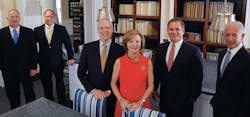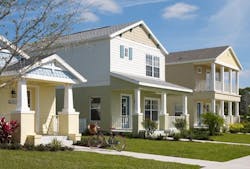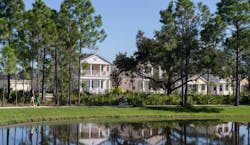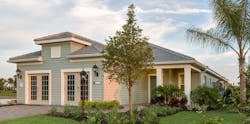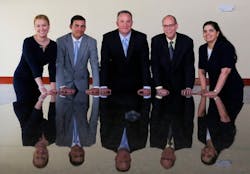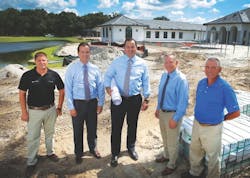There was something about Neal Communities that elicited curiosity from competitors.
Amid the doom and gloom inflicted by the worst recession to hit the construction industry since the Great Depression, Neal was succeeding and growing. The Lakewood Ranch, Fla., builder was not only busy selling homes, but co-founder and chairman Pat Neal was also amassing acres of land without piling up huge debt. While half of the state’s 2,500 home builders went out of business between 2007 and 2012 and many others were treading water in survival mode, Pat Neal, already a prominent builder around Bradenton and Sarasota, marched toward becoming the dominant player in Southwest Florida.
Neal Communities’ sales and closings this year are expected to hit 1,078 and 966 homes, respectively, compared with the company’s 2005 pre-recession peak of 386 sales and 261 closings. Annual revenue from 2012 to last year doubled to $278 million. Increases in units sold and closed and in annual dollar sales have averaged more than 30 percent a year since the company revamped its product in 2008 by scrubbing a townhouse plan in one community and within six months rolling out new and more affordable product that could sell in a down market.
The builder also added to its land holdings in Manatee and Sarasota counties by paying bargain prices during the slump, using cash provided mostly from partnerships with outside investors. Its portfolio of “A” and “B” locations now extends into Lee, Collier, and Hillsborough counties and has paved a path to expand north to Tampa and south with a Naples building division that turned a profit by its second year.
Staying on the Cutting Edge
Now, Neal Communities is loaded with land but light with debt. Its sources of capital are split between financing provided by investors and borrowing from banks. The average cost of its borrowed capital is 4.5 percent, and Pat Neal does not personally guarantee work-in-progress debt.
Initially positioned as an approachably priced product during the recession when the company was retooling, Neal Communities’ cottages have remained popular, even as the housing market rebounds. (Photo: courtesy Neal Communities)
Today his company owns almost 13,000 lots and entitled home sites compared with 5,800 in 2011, has 31 properties, and builds in 26 communities. Neal says he used to sell much more land to home builders but wound up buying the property back when builders defaulted during the recession. Building on his own land enables the company to create fully integrated communities from the ground up with home sites that conform to the chassis and style of Neal’s products. This land fortress has enabled Neal Signature Homes to build communities of upscale homes while semi-custom home competitors are pushed away into one-off, infill locations. “I came to realize that the risk was in the land, and I didn’t see the point of building home sites to sell home sites,” Neal says. “It’s more fun to build home sites to build homes.”
The question asked by builders that watched Neal open new communities during the downturn was, how was he doing it?
“Builders in the market always investigate what other builders are doing. It was like, what was the secret sauce for what Neal was doing?” says Randy Turkovics, who was managing construction with a multistate builder before joining Neal Communities two years ago as president of the builder division. “[Pat] always seemed to be on the cutting edge,” Turkovics says, “and a lot of people were following him.”
Mike Storey also was following the family-owned company. Storey had just departed in 2009 from running the Tampa and Sarasota offices for Taylor Morrison, which was trimming during the recession. Pat Neal contacted Storey through a mutual friend to ask if he would be interested in working for Neal. Storey initially wanted to decline the invitation to meet. He assumed that Pat Neal hadn’t right-sized the business and that it was managed by bankers. But he agreed to talk because he didn’t want to offend Pat. Plus, he was curious.
All of Storey’s assumptions were dispelled within minutes during a Saturday morning meeting. No bankers were around, and Storey could see that Neal had reinvented his business well before the rest of the industry. “People were excited ... enthusiastic. I’d go to sales centers, and they were selling homes, and I got curious. How was this happening? Everyone else was hunkered down still trying to survive. Pat repositioned the business. It really did feel like they were the winning team,” says Storey, who joined Neal Communities as president in 2010.
Fatherly Advice, and a Start
Pat Neal intended to be a banker and entered the University of Pennsylvania’s Wharton School of Finance in 1967. However, his father, Paul Jr., had just moved to the Sunshine State from Iowa to retire. He got bored and persuaded his son in 1970 to work with him in real estate and construction. (Pat returned to Wharton and graduated with an economics degree in 1975.) Paul, a tax attorney and land broker, had seen his father lose everything as a real estate developer in Des Moines during the Great Depression. Pat’s mother, a school teacher, also saw her father, a banker, go broke. Their experiences imparted a lesson to Pat regarding taking on risk and managing land.
“[My father] said, don’t take the risky path—because you’re never too old to go broke,” Pat says. “What that meant was there was nothing in the land development business that required us to take such risk where we might not be able to pay our creditors or maintain the business.”
Their first project was building condos and a shopping center in Longboat Key. Buyers’ deposits for half of the units were enough to attract bank financing. Pat’s father then helped him self-develop a community in Westbay Cove on Anna Maria Island where he graded out the site around a mangrove fringe with a box blade and built a seawall that’s still there.
From that beginning, Pat co-founded Neal Communities in 1974 with his father, along with Frank Buskirk and Howard Adams. He met Charlene Jo Lovingood on a blind date and married her in 1978. Charlene started doing design work for Neal in 1981 when the company was building the Players Club in Longboat Key. Eventually, she opened the builder’s Design Gallery in 2005. Today she owns and manages PureStyle, which designs for Neal Communities and outside clients as well.
Lush landscaping, saving old trees, and preserving wetlands are Neal Communities hallmarks. “If you’re going to be a builder in Florida, you need to emphasize the benefits of living in Florida,” Pat Neal says. (Photo: Taylor Architectural Photography)
When the first of several recessions hit in 1974, the 25-year-old Pat ran and won election as a Democrat to the Florida House of Representatives. Four years later he was elected to the state senate where he chaired three committees including the Senate Appropriations Committee and the Committee on Natural Resources. He had a hand in writing Florida’s first comprehensive wetlands law, codes for growth management, and the state’s first manatee protection law.
By 1986, Florida had turned into a red state, and Neal was defeated for reelection by the GOP landslide that elected the state’s first Republican governor in 20 years. Many conservative Democrats switched affiliations then because they felt their party had moved too far to the left. Pat Neal, who had been president of the Young Republicans in college, was among them. He has since served on the transition team for Republican Gov. Rick Scott, Florida’s Judicial Nominating Commission, as well the Christian Coalition of Florida, and Florida Tax Watch.
Rather than seek elected office again, Pat turned his full attention to home building and developed master planned communities such as Perico Bay Club and University Park, which received a Best Master Planned Community nod from the National Association of Home Builders’ Best in American Living Awards in 1996. Those communities were designed to deliver the “30-second look”: the time it takes buyers to recognize that they are in a place that is special and different from other developments.
Where most builders clear their land, excavate, and then put in utilities and roads, Neal Communities begins land planning by marking which trees to keep and which ones to save and move. Transplanting as many as 100 trees before undertaking development is not unusual for the builder. Then home sites are chosen in a manner that takes the greatest advantage of nature. That’s why roads in Neal communities are not in grids, but rather wind around canopies of mature oak and palm trees, open space, and wetlands. Lush landscaping is a budget priority because it enhances beauty and value. Neal even installs plantings in the rear and sides of its homes.
The Recession and Retrenching
By 2005, the company had built 7,000 homes. It was breaking sales records with 161 employees, was active in at least eight communities, and Pat Neal had just brought in his oldest son, John, to be part of a land acquisition team. But by the spring of 2007, the market began to tank. Neal Communities had a couple of townhouses built in the Forest Creek community in Parrish that weren’t moving. Pat Neal had experienced recessions before, knew another one was looming, and eventually deduced that this downturn would last longer than the others. Initially the company combated slow sales by cutting back the construction schedule and holding off on land deals. But as the slump became more severe, staff was reduced to fewer than 60 employees and Pat told his managers that big changes were needed to survive this one.
“I remember being frightened, and I said to Pat, we’ve been doing this for 20-some years already. We could just take a break,” Charlene says. “He said that was a very selfish thing to think about. He loves what he does. He only wants to work. He doesn’t want to play, and he really did look at it as an opportunity to do something different and maintain jobs and opportunity for the people who have worked hard and been loyal to us.”
Many Neal Communities homes are designed to offer clear sight lines from the front of the house to the backyard. Pictured here is the Victory model at Indigo, in Lakewood Ranch, Fla. (Photo: Ed Chappell)
Architects from BSB Design and Davis Bews Design Group, both in Oldsmar, Fla., were summoned to an August 2007 meeting for ideas about what to do with the townhouse plan. One suggestion was to pull them apart into single-family units that were smaller than other homes built in Forest Creek. Those houses were as big as 2,500 square feet and sold for as much as $550,000. The architects and Neal Communities’ designers looked at communities in Tampa with lower-priced product for inspiration and designed three cottage concepts as small as 1,162 square feet on 25-foot lots with prices starting at $120,000.
Initially, residents who had bought more expensive homes opposed the cottages, fearing ruined property values. A series of meetings with local officials and residents won them over with arguments noting the recession already had decreased their property values and nearby home sites standing empty would depress them further. Another big hurdle was zoning. The development was initially zoned for townhouses, and getting changes approved by the local government typically took a year or longer. But Pat had almost four decades of home building experience and relationships with local officials who trusted him. The county approved the plans and setbacks by December, and nine cottage models debuted at a February open house that drew 1,100 visitors.
“It was truly an amazing experience to be here through the downturn and watch Pat formulate a plan for us,” says Cathy Engels, vice president of purchasing. “We did lose a lot of employees and that was hard for us, but we had a really strong core group and pretty much turned on a dime. We had a whole new product line, whole new spec levels, the whole bit, and we went about six months from concept to going to apply for the permits.”
Among Neal Communities’ approximately 240 current employees, 44 are long term; many have tenures of at least 15 years, and some have been with the company for 30 years or more. That core group value-engineered existing designs to wring out cost in trusses and elevations. The purchasing staff worked to unitize costs with subcontractors, many of whom were undermanned and lacked the staff and capacity to handle multiple estimates and bid submissions. Instead of giving work to outside vendors, Pat Neal started ancillary businesses, such as a property management company, and put his employees into those operations rather than let them go.
Twenty-seven of 78 cottages were sold by the following August. The houses featured an open floor plan, front porches with Craftsman columns, and windows strategically positioned to maintain privacy yet large enough to bring the outdoors inside. The cottages, though initially positioned as a minimally priced product, are popular today as a premium-priced amenity at other communities for buyers who want a lakefront home.
In some models, you can see the lush patio and landscaping in the back of the house as soon as you step through the front entrance, a design principle that Pat learned from Jack Bloodgood, one of the founders of BSB Design. “That was one of his rules, and that has become a Neal rule,” Pat says. Bloodgood lived in one of the homes on Pat’s route when he delivered newspapers as a boy growing up in Des Moines. The newspaper delivery client relationship grew into a 52-year friendship that lasted until Bloodgood died last January.
Coming Through and Scaling Up
Momentum returned. After sales dropped to a low of $69.52 million in 2009, revenue grew to $74.7 million in 2010, and Pat Neal would build his 8,000th home by mid-2011. He expected that more homebuyers, retiring empty nesters and young families, would see Florida’s Gulf Coast and surrounding area as a desirable place to live, so he wanted to aim for a future selling 1,000 houses a year. Yet he was concerned that “the lug nuts would slip” at that pace. Scaling up would require more structure and discipline.
“This company came through the worst economic recession since the 1930s better than anybody else, and they didn’t need somebody like me to come in and tell them how to do it better,” Storey says. “That wasn’t the story. The story was that they were doing it exceptionally well at 164 units. That wasn’t going to work at 500; that wasn’t going to work at 1,000. There are things we do today that won’t work at that level. It’s really about preparing the organization by getting the people, process, and systems in place before we get there.”
The small, private builder had grown by being opportunistic. Pat would acquire land sometimes by simply courting a farmer for years with friendly visits until eventually the owner sold. Initially, the organization was siloed. One department developed the land and then let someone in sales know that lots were ready to sell. Sales would scramble to get a model built and then hand the baton to someone else to develop a marketing plan.
Storey merged land and building into one organization. (Pat and his son John own and manage a separate land acquisition and entitlements business.) Now when land is acquired, the property goes into an operation planning system that schedules every phase of community building from land planning and permitting to the grand opening. The builders and sales and marketing people all have their checklists, and the whole process works together. The executive team meets every two weeks to go through each community to review performance and scheduling. Also, the communities get audited every month by managers who visit the properties to inspect the signage and model homes and to scrutinize marketing.
Part of scaling up involved having all employees invested in the outcome by letting them know what’s happening. So staying on top of sales on a daily, not weekly, basis became a company priority. That expectation demanded that even designers had to dig into the numbers.
“I’m a creative person, so for me the numbers don’t matter because the design is beautiful,” says Kathy Forinash-Cioffi, vice president of design. “Mike taught me so much in our process and thought development. If we’re selling a plan lineup with five plans and only three are selling, then what is the problem with the other two? I’ve put a lot of programs in place so I can find out what’s selling in a particular community in an instant. Mike challenged me to put that information at my fingertips. He taught me to look at the numbers and get out of the design box.”
As Neal Communities’ core buyer is more apt to spend on upgrades, getting those offerings and the prices right was important. “The big thing for us is providing the dashboard, getting the information down to the team so they can make decisions,” Storey says. “[Kathy] now has a recording system where she can see every week how an elevation is doing. We shouldn’t have product, design selections, or plans that don’t sell. Those are things you have to do really well to be really good in this business.”
Schooling for Success
For a local builder like Neal Communities, the biggest hurdle in maintaining a top-tier salesforce is competing with larger builders that steal good people. “Sales associates get lured away by the glam and once-a-year glitzy giveaways,” says sales director Nicole Brooks. “With social media, it’s more in their faces than ever.” Neal Communities, on the other hand, recognizes its people all year round, with distinctions such as the Slight Edge Award, which recognizes salespeople whose team mindset, exceptional customer service, and yes, sales numbers—go above and beyond.
Awards are nice, but the enrichment in which Neal invests most is training. To stay competitive and retain employees, the builder founded Neal University two years ago. “It wasn’t hard to talk Pat into this,” Brooks says. “The investment isn’t about money, it’s about a consistent sales team. We focus on training, and he knows the importance of a well-trained sales team.”
Though Neal recruits experienced sales folks, many are new to the home building industry, seasoned instead in insurance, high-end retail, or pharmaceutical sales. “They don’t have bad habits yet,” Brooks says. “We don’t have to retrain them.” Does she draw talent from the automotive industry? Not so much. Car salespeople, Brooks contends, tend not to possess the customer service skills that Neal is looking for.
Neal University is a regimented, three-month intensive course in new-home sales and the company’s culture. Month 1 is devoted to the home building industry, the design center, purchase agreements, selling psychology, home building science, and bonding with team members. Month 2 covers the sales center and feature selling, as well as mastering discovery questions, involvement questions, and the close. In Month 3, sales associates go out into the field. Everyone is mystery-shopped during that month, and to graduate from Neal University, students must sell a home within that period.
The program is a hybrid of sales techniques from the trainers that Brooks admires most; they’re names you may know from these pages, including Bob Schultz, Myers Barnes, Jeff Shore, and Mike Lyon. Attendance at Neal University is mandatory for all new salespeople. The numbers say why: A three-fold increase in sales has resulted since the program began.
Neal South: Expansion
Expanding into new territory can be painful; builders often wind up constructing product they’re not proud of. Permitting and local building officials are unfamiliar. Finding reliable subs can be trial and error, mostly error, and buyers don’t know who you are. Michael Greenberg was hired three years ago as Southwest Florida regional president to launch a new division building in Fort Myers, Estero, and Naples. The Toll Brothers and WCI veteran came onboard after extensively vetting the company through his industry contacts and even visiting Neal properties to grill salespeople before deciding to interview for the job. Greenberg had experience opening new territory for regional and national builders and was already impressed with Neal Communities’ approach to scaling up.
Left to right: Tashara Cronshaw, director of human resources; Jason Frost, VP of land acquisition; Christopher Clark, VP of operations, north region; Jim Schier, senior VP of finance; Nancy Reynolds, CFO. (Photo: Gary Bogdon/DB Photo Agency)
“Having lived it, I know the business of scaling and knew that [Neal] was interested in doing it in a managed way. That’s different for a private company. You’re not growing for the sake of growing or for shareholder demand. You’re growing because you have a brand, and you’re really committed to what your brand means and stands for, and you want to connect with as many people as you can,” Greenberg says.
Being the new kid on the block, Greenberg saw his biggest challenge as presenting credibility to a market that had never heard of his company. The first year, he worked out of his Naples condo and established relationships with local media, taking public speaking opportunities at Florida Gulf Coast University, serving on the college’s board for real estate curriculum, and undertaking community outreach, such as inviting fire departments to burn down uninhabited structures on Neal properties so emergency responders could practice fighting fires.
In the first year, the division started building on distressed lots and buying land to build a base for the future. Neal South has now accumulated enough land to complete 175 homes in five communities and 750 units by the time those projects are built out. “I have a strong background in land acquisition and entitlement, so Pat and I mirrored each other. It’s a good balance of giving me the support I need and the autonomy to drive the business because we trust each other,” Greenberg says.
His strategy was to acquire tracts of land that were smaller than what the nationals would grab for master plan developments around Fort Myers. As Neal recognized when he launched the Cottage Series in Lakewood Ranch, buyers had changed. The active adult still wanted to live in a place that didn’t compromise his or her lifestyle but sought a lower price. For decades, builders provided amenities inside gated communities and tacked on fees to pay for them. Neal South differentiated by selling privacy and lifestyle plus proximity to high-end shopping and restaurants, beaches, golf courses, entertainment, and other infrastructure that didn’t exist outside gated communities 20 years ago.
“We said we’re going to go amenity light,” Greenberg says. “That’s how we presented it to the public, and that allowed our fees to be lower because the amenity now was the community at large. [Buyers] could pay and play as they chose rather than pay for things they didn’t use often. That allowed us to look at land positioning differently in terms of the size requirements and capacity. It allowed us to match price points with cash flow requirements for paying fees in a very compatible way.”
Greenberg added staff on a just-in-time basis as the business grew, eventually opening an office in Bonita Springs. That office had 39 employees as of November and a Design Gallery was slated to open there in December. In just three years, Neal South is the fifth largest builder in Lee County, and Greenberg expects his division will be the builder of choice to work for, judging from the résumés coming in as Neal South adds staff. “Michael took our brand, employed it downstate, and stayed true to the brand and culture of the company,” Storey says.
Playing Well With the Neighbors
As any builder knows, community support can make or break a project’s getting done in good time—or at all.
Ivory Crofoot started out in Neal Communities’ permitting department but didn’t stay for long. “It was clear that I was more social than necessary,” laughs Crofoot, a self-described military brat who has lived all over the world. Her extroverted nature was quickly put to good use: As Neal’s community relations and government affairs coordinator, Crofoot meets with the neighbors—all of them—to get buy-in on a project. “This is a retirement area—anytime we propose a community, there’s always someone who doesn’t think the area should change,” she explains. “But we’ve never been denied a property.”
From sand blowing into a neighbor’s swimming pool to downed tree branches in adjoining yards, Crofoot is the go-to. “I’ve stood on a neighbor’s patio to make sure that trucks going by weren’t making vibrations,” she says. What happens if they do? “We change the timing, so the majority of the work is being done when people aren’t home,” she says.
“It’s not something we speed through; it takes time,” explains Crofoot, describing the gradual process of getting a thumbs-up from residents on the rehabbing of Boca Royale Golf and Country Club, at the time a failing golf community. Crofoot, either by herself or with Pat Neal, met with each of the 386 households in the community, canvassing door-to-door and sitting in living rooms. The builder led 17 bus tours to show residents the success it had had with similar communities. “Every question got answered, and now everyone is a member of that club,” Crofoot says (just 80 percent buy-in was needed). “If you ask anybody at Neal, they can tell you who all the neighbors are in our adjacent properties,” she says, noting that Pat himself goes to every single homeowners’ association meeting that’s held.
“Nobody walks out of my office upset, and I never walk out of their home upset,” Crofoot says. Holding an open door for communication is what sets Neal apart from other builders in the area. “If I have an angry homeowner, the first thing I want to do is talk to them,” she adds, proudly noting that residents usually reach her by phone on the first try. “And a massive number of business cards are printed for us because we give them out so much.”
A Supermarket Epiphany
Pat Neal had a revelation decades ago: He couldn’t run his business in a way that forced him to hide from customers. It almost happened when he was grocery shopping and spotted a homeowner who had called earlier that day because his air conditioning wasn’t working. Neal lingered “behind the corn flakes” for camouflage, then thought better of it and approached the homeowner, who was delighted to report that the warranty team had fixed the problem.
Signature Homes is Neal’s custom division. Left to right: Nicole Brooks, director of sales; Cathy Engels, VP of purchasing; Kathy Forinash-Cioffi, VP of design; Leisa Weintraub, VP of marketing and creative director. (Photo: Gary Bogdon/DB Photo Agency)
Neal Communities’ commitment to keeping customers happy can involve taking care of problems long after the warranty has expired, resulting in clients who return to buy their second and third Neal homes. The company has built more than 10,000 homes in 45 years with great financials, enabling Pat and Charlene to give $8 million to various charities, including $6.9 million to help Manatee County buy a 120-acre nature preserve on Sarasota Bay.
In 2010, Neal Communities merged its land and building divisions. Left to right: Ryan Fowler, land development manager; Michael Neal, land development manager; Mark Evans, VP land development; Randy Olson, land development manager; Dan Bastien, site merchandising manager. (Photo: Gary Bogdon/DB Photo Agency)
“Being a private builder gives us more opportunity and flexibility to do what’s right for our customer,” Pat says. “We work with people as individuals. It’s a long-term commitment to our community and a long-term commitment to customer satisfaction.”
Environmental Stewardship As Company Culture
Not only is environmental stewardship good business, it makes for more appealing places to live and is a core value that permeates Neal Communities. “The top priority is to make this place look as if we just dropped in some roads and homes,” says Mark Evans, vice president of land development. It’s an ethic that has deep roots.
A good while before the term “green” made it into the mainstream, Pat Neal was onboard. He opened his development business 45 years ago, “17 days after the first Earth Day on April 22, 1970,” he notes. Florida had less than stellar environmental practices at the time—preservation wasn’t yet the law—but Neal Communities began using rip-rap instead of beachfront retaining walls, as well as building seawalls around mangroves so that trees remained as shoreline stabilizers and wetlands were preserved as natural habitats.
A long-time interest in the environment and hands-on experience with permitting saw Pat Neal chosen as natural resources chair during his dozen years of service in the Florida State Legislature in the 1970s and ’80s. Under his leadership, legislation was enacted on wetlands, hazardous waste, endangered species, and land preservation. He has been honored by the Florida Audubon Society, the Sierra Club, and the League of Conservation Voters, and Neal Communities was named Builder of the Year in 2013 and 2014 by the Florida Green Building Coalition.
“As a company, we give up density and premiums in order to preserve native lands,” Pat says. Substantial portions of Neal Communities’ developments are devoted to land preservation and nature trails. Particular attention is paid to tall trees and native species; an entire boulevard was once moved to save a tree (a snapshot of the Neal team hugging a large Aristotle oak can be seen on the company’s website).
Grand Palm, a development of nearly 2,000 homes that range from about 1,100 to 2,900 square feet, began construction in 2012. There will be nature trails, with one-third of the land devoted to wetlands and uplands. Pat Neal was so committed to building lightly on the land and getting it right that he went on site to lay the road himself. “I tripped over a palmetto and went face down into the water,” he admits, “but that’s part of the deal.”
About the Author

Mike Beirne
Mike is the senior editor of Pro Builder and Custom Builder magazines. A two-time Jesse H. Neal Award winner, Mike has nearly 30 years of journalism experience plus numerous news and feature writing awards, including honors from the Society of Professional Journalists, the American Society of Business Press Editors, and the National Association of Real Estate Editors. He also operated a masonry restoration business for more than two decades. [email protected]
